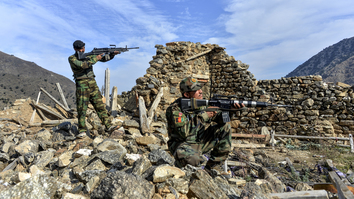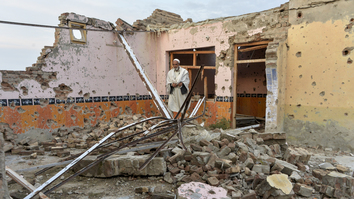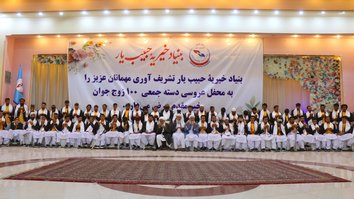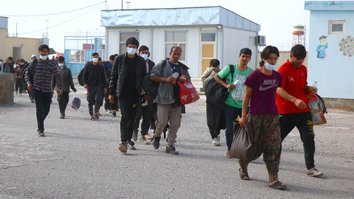JALALABAD -- Residents of Nangarhar Province, once the headquarters of the "Islamic State of Iraq and Syria"'s Khorasan branch (ISIS-K), are rebuilding their houses as life returns to normal.
But Afghan forces are keeping up the pressure on the fractured terrorist group, hunting down its remnants as the group has claimed responsibility for a number of recent deadly attacks.
ISIS-K issued a statement in November 2019 admitting the group's defeat in Nangarhar after the Afghan National Defence and Security Forces (ANDSF) dealt the group a series of territorial setbacks.
Continued operations against the group have hemmed in the remaining members and and curtailed the group's revenue sources, United Nations monitors reported May 27.
![A screenshot of a video posted on September 22 shows a group of ISIS members gathered in an undisclosed location in Afghanistan. [File]](/cnmi_st/images/2020/11/17/27055-isisk-585_329.jpg)
A screenshot of a video posted on September 22 shows a group of ISIS members gathered in an undisclosed location in Afghanistan. [File]
Many ISIS-K fighters have been captured or surrendered, while others, including some leaders, went into hiding as Afghan forces hunt them down.
In August, Afghan authorities reported the killing by their intelligence special forces of Abdullah Orakzai, the chief justice of ISIS-K. They did not disclose the date or location of the event.
Orakzai was the mastermind behind an ISIS-K-claimed attack on a prison in Jalalabad earlier that month that killed at least 29 people, the National Directorate of Security (NDS) said.
Afghan security forces also captured two of the suspected masterminds behind a deadly attack on Kabul University earlier this month and killed another, officials said November 16.
The "main mastermind", Mohammad Adel, was responsible for an ISIS-claimed attack on Kabul University on November 2 that left at least 22 people dead and another 27 wounded.
Adel, who was arrested, was also behind an October 24 attack on the Kawsar-e-Danish education centre in the Dasht-e-Barchi neighbourhood of western Kabul, say authorities. That suicide bombing killed 24 people and injured more than 50, most of them young students.
ISIS on the run
The campaign to arrest ISIS stragglers is ongoing, said Gen. Ghulam Sanayee Stanikzai, the police chief of Nangarhar Province.
"Two-and-a-half years ago, no one thought that ISIS could ever be defeated," Stanikzai said. "Now there is no threat from ISIS to Nangarhar."
"ISIS was strong in the Shinwari region," he added. "It tried to expand its control to Pacheragam and Khogyani districts."
"[ISIS-K] made efforts to stay in Tora Bora, which has caves and could have been a safe haven... but our forces and public uprising groups put pressure on them to leave those areas."
After the ANDSF delivered major blows to ISIS, some of its members went into hiding and are arrested as they surface, said Habiba Kakar, deputy governor of Nangarhar.
"Our [NDS] forces capture a number of ISIS fighters, including its key figures, every month in their operations, and this campaign is under way," she said.
"I am confident that ISIS fighters won't be able to emerge again in Nangarhar," she said. "They make efforts to do so, but our forces will not allow them to raise their heads."
Locals recount resistance to ISIS
Residents of Nangarhar Province who once fought against ISIS-K have returned to their normal lives.
In late 2014, ISIS-K surged in Achin, Haska Mina and Nazian districts. A few months later, the terrorists killed 12 tribal leaders of Nangarhar, sparking public uprisings against the group.
"When ISIS came to Kot District and slaughtered civilians on the large bridge [in the district], we decided to rise up," said Nazar Muhammad, a resident of Barkot in Kot District who served in uprisings against ISIS-K, in an apparent reference to the slain tribal elders.
"We took our weapons and started to fight ISIS. We destroyed ISIS within two-and-a-half years and ousted it from Kot District."
"If we hadn't come together, it would have killed us one by one. We are happy to live normally now," he said.
"When ISIS took over, it was a disaster," said Malak Kameen, a tribal elder who lost many family members and relatives to ISIS-K.
"Our whole population had to leave our houses and move to other places to live in rental properties. We went through much hardship, and there were days we had to sleep hungry," he said of his neighborhood. "Now that ISIS has been defeated with God's mercy, we were able to return to our areas and resume our ordinary life."
"Gorgorai was one of the headquarters of ISIS," said Fazal Muhammad Shinwari, a resident of the area in Haska Mina District.
Shinwari recently rehabilitated his house, which was destroyed in mine explosions when ISIS-K was in control.
"This market... was thriving and crowded six or seven years ago, but when ISIS came, it opened bases and courts in stores at the market that it used to slaughter civilians," he said.
"Some houses are still left ruined, but residents live in them because they think they are better than rental houses," he said. "Now, there is no fear of ISIS, and civilians can live a normal life."
The process of rehabilitating houses that were destroyed during the conflict with ISIS continues, and dozens of houses that ISIS ruined have been rebuilt with government support, according to Ataullah Khogyani, a spokesman for the Nangarhar governor.
"Houses of many residents have been rebuilt in Achin and Kot districts, and many more will be rehabilitated based on special instructions from the president," he said.

![Afghan troops are shown July 29 in Achin District, Nangarhar Province. [Khalid Zerai]](/cnmi_st/images/2020/11/17/27059-pak1-585_329.jpg)







ISIS has already been destroyed and cannot launch operations, but the important issue is Taliban who are is still active and are victimizing the Afghan security forces on a daily basis. You have to speak about defeating of the Taliban, and what the government has done against the Taliban. Day after day, Taliban make progresses, and the government hands over territories to Taliban. If the government does not make an organized plan, Taliban will reach to the gates of the city next year, because Taliban now have a physical presence three kilometers away from most of the country's cities. There is always the possibility of an attack on the cities.
Reply3 Comment
Long live our country’s brave and courageous forces. We believe in our own forces. They can defend this soil’s honor and dignity.
Reply3 Comment
To be honest, ISIS was supported by America and the National Directorate of Security of Afghanistan against the Taliban. This is a very obvious thing for the educated people. Now that the foreign forces are withdrawing from Afghanistan, ISIS fighters are obliged to stop the war and flee. If they do not escape, they will be destroyed by the Taliban. In order to defame Taliban and make the people stand against them, America was indirectly involved in most of the explosions and attacks that have taken place in the cities of Afghanistan. America did everything but failed to defeat the Taliban and was eventually forced to sign a withdrawal agreement with the group.
Reply3 Comment